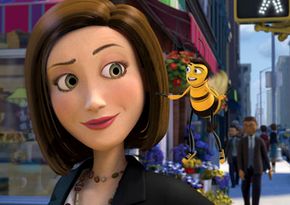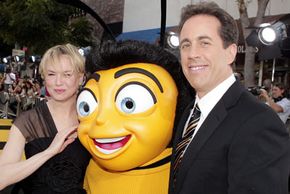In the near-decade since the end of his eponymous sitcom, comedian Jerry Seinfeld returned to his stand-up comedy roots and -- occasional talk show appearances notwithstanding -- has steered clear of the Hollywood spotlight. But, in fact, for the past four years, he has been hard at work on a film that marks his first foray into animated features. "Bee Movie," which hits theaters Nov. 2, 2007, is a computer-animated comedy showcasing Seinfeld's idiosyncratic humor. In this article, we'll cover the movie's development from idea to screen.
As the writer, producer and star of "Bee Movie," Seinfeld brings his unique comedic style and vision to animated life with the help of directors Simon J. Smith and Steve Hickner, voice actors including Renée Zellweger, Matthew Broderick, Chris Rock, John Goodman, Sting, Oprah Winfrey and Ray Liotta, and several hundred artists, animators and other crew members.
Advertisement
It all started with an offhand comment to Steven Spielberg, with whom Seinfeld was having dinner. "Wouldn't it be funny if they made a movie about bees and called it 'Bee Movie'?" Seinfeld mused. Spielberg thought it was actually a good idea, called Jeffrey Katzenberg of DreamWorks on the spot, and the next thing Seinfeld knew, he had a deal -- and had to come up with a movie to go with his title.
"There were many versions, probably two and a half years of different ideas and stories until we had one that we felt would work," Seinfeld says. His final version -- the 212th incarnation of the script -- centers around an independent-minded bee named Barry B. Benson who ventures outside the hive, where he forges a friendship with a florist (Zellweger), discovers that humans are stealing honey, and takes his indignation to the court system, where he faces off against lawyer Layton T. Montgomery (Goodman).
During the casting process, Seinfeld called upon friends like Rock (as a mosquito Barry meets on a windshield), Broderick (as Barry's best friend, Adam) and Patrick Warburton (who plays what Seinfeld calls "a little more aggressive and a little dumber" incarnation of Puddy, his "Seinfeld" character). He defied convention by recording with each of them instead of editing together solo performances.
"As the writer, I know what we're going for, and it makes things easier," Seinfeld says. But coming from TV and stand-up, he never could get used to the slow idea-to-execution process in animation. "The pace of it is very difficult," he says. "You suggest something and it could be weeks before you see it, so you have to remember what you said, and sometimes you forget. That happened a lot."
For research, he visited a beekeeper -- and got stung for his trouble -- but gained invaluable knowledge about bee flight patterns and social hierarchy. The filmmakers and artists also took field trips to apiaries ("bee farms"), studied hundreds of photos and spoke to bee experts. Among the odd facts they learned: If bees didn't pollinate, the resultant imbalance of nature would cause humanity to collapse within four years -- and it takes 17 bees to make one teaspoon of honey. The knowledge had an impact. Director Smith says he felt guilty enough to stop eating the sweet bee product. "We felt bad for those guys," he says.
Next, we'll learn more about the "Bee Movie" directors and the production process.
Advertisement



